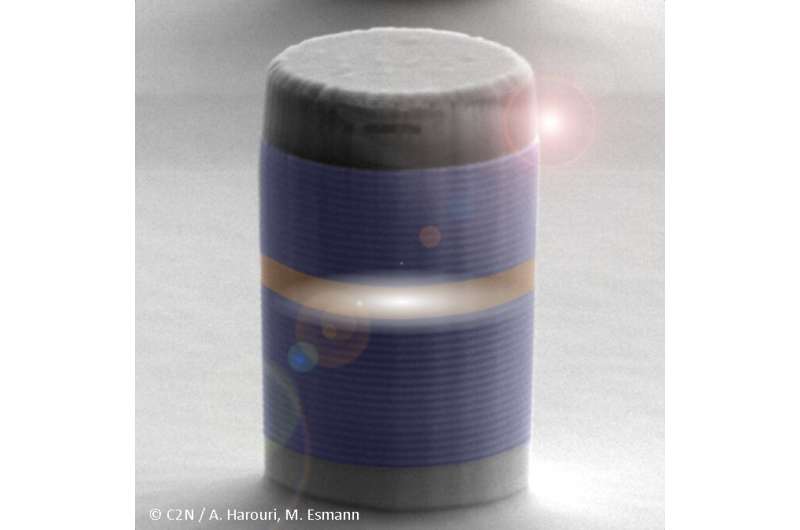Confined nanoscale sound controls light in a microresonator

When traversing a solid material such as glass, a light wave can deposit part of its energy in a mechanical wave, leading to a color change of the light. This process, called "Brillouin scattering," has important technical applications. Long-range optical data transmission on the internet, for example, relies on amplifiers generating mechanical waves in an optical fiber via a strong laser light field. The frequencies at which mechanical waves can be optically excited, and hence the optical spectra that can be generated through Brillouin scattering, are usually dictated by the material properties. So far, this has limited the range of possible applications.
Researchers from the team led by Daniel Lanzillotti-Kimura at the Centre de Nanosciences et de Nanotechnologies-C2N (CNRS/Université Paris-Saclay) have recently demonstrated a micropillar made from alternating layers of two semiconductor materials that constitutes a novel device to control light with sound. The micropillar device can shape an optical spectrum through Brillouin scattering almost completely at will. Their work was published in the journal Optica.
The main trick behind the device's versatility is controlling light and sound with separate parts. In the state-of-the-art technology facility of the C2N, the researchers fabricated micropillars in which the inner layers, with extremely fine thicknesses in the range of a few nanometers, constitute a resonator for sound waves at particularly high frequencies of 300GHz. This resonator is embedded between thicker layers, which resonantly confine light. Since light and sound are confined in the same spatial region in all three dimensions of space, the device is also unusually efficient in Brillouin scattering generation in comparison to its size.
In their study, the researchers devised a novel optical technique to detect and optimize the generated Brillouin spectra under the influence of thermal effects. But the impact of their discovery goes well beyond that: Micropillar resonators can be directly interfaced with optical fibers. Therefore, they comprise a promising platform to integrate Brillouin light sources with optical nano-circuitry on a chip. The researchers also point out that their device may be combined with active lasing media and could even be improved to reach the regime of active acoustics, that is, the mechanical wave analog of a laser.
More information: M. Esmann et al. Brillouin scattering in hybrid optophononic Bragg micropillar resonators at 300 GHz, Optica (2019). DOI: 10.1364/OPTICA.6.000854
Journal information: Optica
Provided by Centre for Nanoscience and Nanotechnology




















